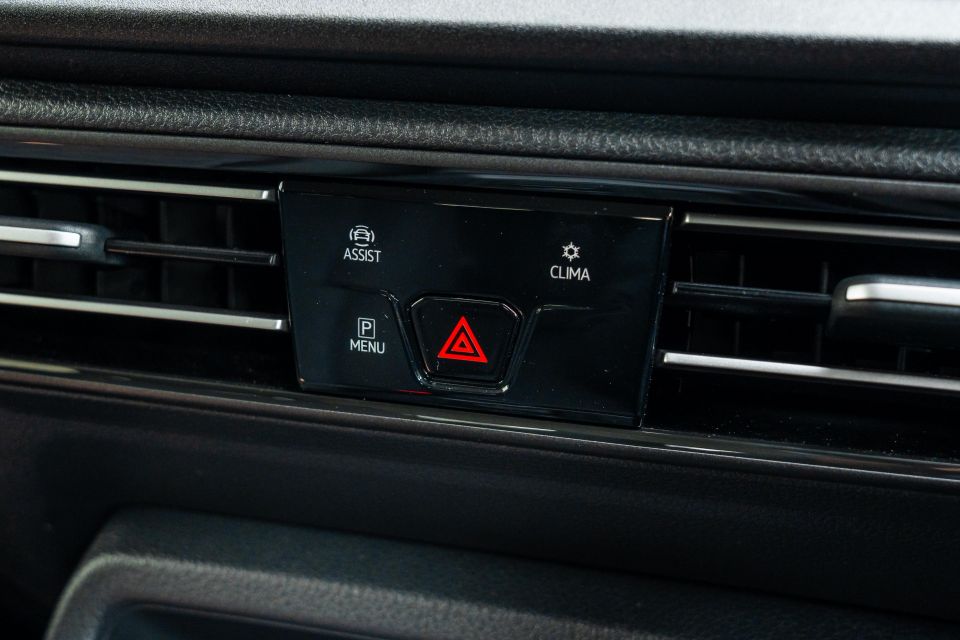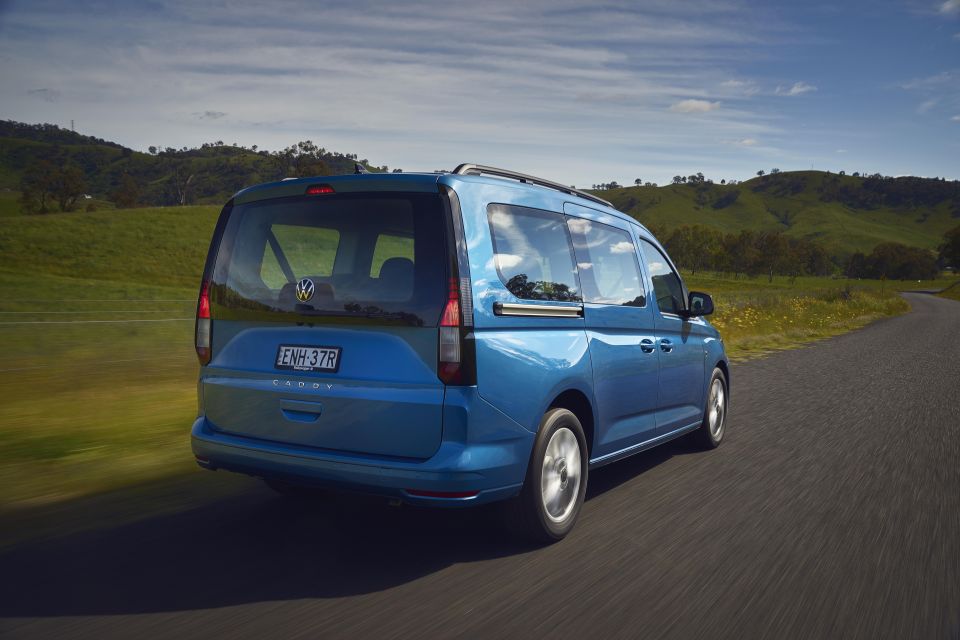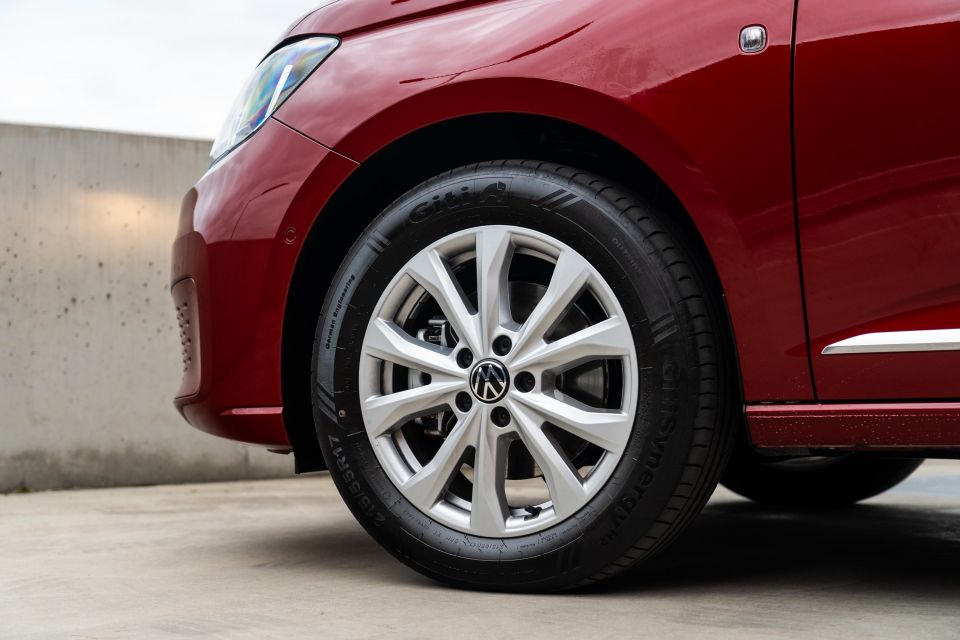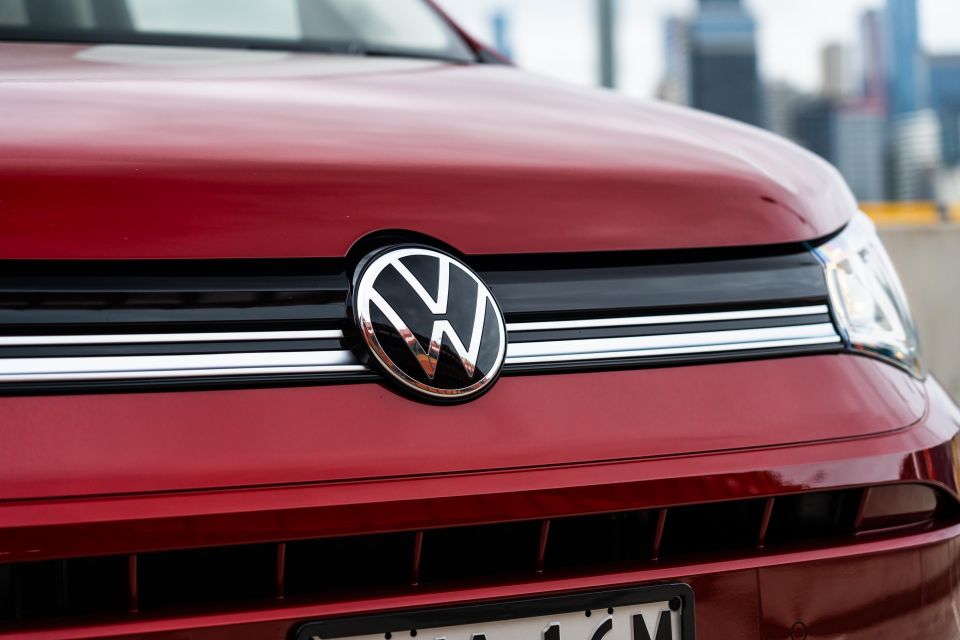

Dave Humphreys
2025 Volkswagen Transporter review: Quick drive
6 Months Ago
The Volkswagen Caddy Maxi people mover offers van practicality with car-like driving dynamics. It doesn't come cheap, however.



Contributor

Contributor


Contributor

Contributor
Quickly see how this car stacks up against its competition. Select any benchmark to see more details.
Where expert car reviews meet expert car buying – CarExpert gives you trusted advice, personalised service and real savings on your next new car.
While many Australians may only know the Volkswagen Caddy exclusively as a commercial van, it’s also available as a rather practical people mover.

Locally, the Caddy Maxi offers seven seats, and is available with two powertrains and two trim levels. On test here is the flagship Caddy Life Maxi with the TDI320 four-cylinder turbo-diesel powertrain.
This van-based model forms as the entry point to Volkswagen’s people mover range in Australia, given we’ve never received the Touran. Larger VW people movers in the local lineup include the Multivan and Caravelle, and will soon include the electric ID. Buzz.
The Caddy is the smallest size of traditional people mover on sale in Australia, though there are plenty of seven-seat SUVs that are similarly priced and sized.
The current-generation Volkswagen Caddy was unveiled in early 2020 and launched in Australia in late 2021. It’s based on a version of the monocoque MQB Evo platform that underpins the likes of the Volkswagen Golf Mk8, Skoda Octavia and Cupra Formentor, among others.

There haven’t been any updates to this model yet, though globally Volkswagen has unveiled a plug-in hybrid (PHEV) powertrain option, which is yet to be confirmed for Australia.
How does this characterful and compact German people mover hold up against the ever-growing wealth of seven-seat crossover SUVs? Read along to find out.
There are a total of four Caddy Maxi people mover variants offered locally. Our tester is a turbo-diesel powered Life.

| Model | Price before on-road costs |
|---|---|
| 2025 Volkswagen Caddy Maxi TSI220 | $52,290 |
| 2025 Volkswagen Caddy Maxi TDI320 | $54,290 |
| 2025 Volkswagen Caddy Life Maxi TSI220 | $56,790 |
| 2025 Volkswagen Caddy Life Maxi TDI320 | $58,790 |
In addition to the Caddy Maxi people mover range, there’s the Caddy California camper van, as well as the Caddy Cargo light commercial van.
To see how the Volkswagen Caddy stacks up against its rivals, check out our comparison tool
Buy your new car without the stress. It's fast, simple and completely free.

Great service from Travis and team, second time I have used this business would not hesitate to recommend them to anyone
Craig C.
Purchased a Ford Ranger in Sunshine Coast, QLD
CarExpert helped Craig save $7,224 on his Ford Ranger, now let us save you on your next new car.
Get your BEST priceMuch like a Golf, but super-sized.

Walking up to the Caddy, the first thing I realised is you need to fish the key out of your pocket to unlock it. Proximity entry is an optional extra, which is a little wild given our tester costs over $60,000 drive-away.
This is even more confusing because the Caddy Life comes standard with keyless entry. Thankfully, there’s somewhere you can put the key fob on the centre tunnel, but it’s annoying have to pull it out in the first place.
This people mover has rather large front door apertures and a high-set seating position, which makes ingress and egress easy. You also step across into the cabin rather than hopping up into it, like you would in a crossover SUV.
As standard, the Caddy has so-called ErgoComfort front seats. These have to be one of, if not the most comfortable seats I’ve sat in. They are so squishy yet supportive, providing the perfect place for long road trips.
Both front seats are manually adjustable, which is also surprising given the car’s asking price, but you can lift up the front of the seat base and there’s also a thigh extender. These are both great for those with longer legs, like myself.


Ahead of the driver there’s a nicely sized steering wheel that fills your hands. Its leather wrapping feels buttery soft and premium, and there’s also plenty of tilt and reach adjustment so people of different heights and statures can get comfy behind the wheel.
Another positive is that the Caddy’s steering wheel has proper physical buttons, rather than the glossy black haptic ‘buttons’ that are thankfully being phased out across the range. They’re all clearly signed and logically placed.
Behind the steering wheel is a 10-inch digital instrument cluster that’s common with the Mk8 Golf. It can be configured in countless different ways, though you can’t show mapping because this car doesn’t have satellite navigation as standard.
Moving across, the 8.25-inch touchscreen infotainment system now looks rather small in a new car. It’s basically the same size as my iPhone 15 Pro Max. You can get a larger 10-inch unit as part of an option pack, which fills the space a bit more nicely.
Despite its small size, the touchscreen appears high-resolution and is very responsive to touch inputs. The interface is also easy to understand and navigate, so you can’t really get lost.


A strange touch is the removal of the touch slider under the touchscreen, which is typically for volume and climate controls. Instead there’s a divot where it usually resides.
Thankfully, there’s a physical knob beside the touchscreen for adjusting the volume, but you need to dig into a sub-menu to change the climate controls. This is a common gripe with current Volkswagen vehicles.
Something that took me by surprise is that the Caddy Life Maxi only comes with wired Apple CarPlay and Android Auto as standard. You need to plug your phone into one of the USB-C ports ahead of the gear selector. For this vehicle’s asking price, you’d rightly expect standard wireless smartphone mirroring compatibility.
Wireless smartphone mirroring is available as a $75 standalone optional extra, or as part of the $1740 Navigation Package that also brings the larger touchscreen and satellite navigation.
As is to be expected with a wired smartphone mirroring connection, there were no dropouts whatsoever during my week of testing.

Besides the two USB-C ports there’s a wireless smartphone charger that has a clever fold-down lid so you can put stuff on top of it.
Looking around the cabin, it’s hard to hide the Caddy’s commercial vehicle roots. There are plenty of hard plastics, but the high-touch points like the armrests are still soft and supple.
A benefit of the van-like nature, however, is there’s plenty of storage up front. This includes a huge storage area above the windscreen, nooks on top of the dashboard, deep door bins, as well as an adequately sized glove box and centre console box.
Another positive is that the cabin feels large and airy due to the huge amount of headroom and large windows. If you opt for the fixed panoramic glass sunroof it’s even airier and rather special-feeling, given this car is pigeon-holed as a boring people mover.
The last thing I’ll mention before discussing the second and third rows is this Caddy feels considerably better put together than other recent Volkswagen Group vehicles I’ve driven. Everything feels solid, though our tester had a rattle near the windscreen, and another developed towards the back of the cabin.


Hopping into the second row, you need to use the sliding doors which are rather heavy. If you park on a hill there isn’t much holding them locked back into place, and with some momentum they could potentially pinch little fingers very easily, or worse. I’d love to see power sliding side doors become available.
Once you’re sat in the second row it’s rather spacious, plus the stadium-style seating allows you to have clear forward visibility. The bench seat isn’t quite as squishy as the front seats, but it’s still comfortable enough. The backrest also reclines to allow more passenger comfort.
Like up front, passengers in the second row have heaps of headroom, as well as great shoulder and toe room, though legroom is adequate. It’s also easy to go three abreast in the second row of the Caddy. You do get more second-row space in a Kia Carnival or Hyundai Staria, though they are both larger overall.
Second-row amenities include cute fold-down tables for the outboard seats, air vents on the back of the centre console, USB-C ports and big door bins. A let-down, however, is that there’s a load of hard plastics that reveal the commercial van roots here.
Hopping into the third row is pretty easy once you know the steps. It requires you to pull a string to fold the middle seat, and then another to tumble it. I do wish there was one string that did both of these functions.

Another gripe about getting into the third row is that the larger portion of the 60/40-split folding second row is kerbside in Australia. This means if you want to use/access the third row you can’t have child seats fitted on the left-side or central second-row seats.
Speaking of fitting child seats, the Caddy offers ISOFIX points on the two outboard second-row seats and two third-row seats, as well as top-tether anchors for all second- and third-row seats.
The third-row seats are noticeably thinner and harder than the ones in the other two rows, but you still have enough space for adults and the stadium-style arrangement alleviates any potential claustrophobia.
There’s basically exclusively hard plastic back there, and there aren’t any major storage spots, and also no air vents.
Around the back, the Caddy has a humongous tailgate that you need to account for when reversing into a parking space. It’s manual-opening as standard, and requires a fair pull to close in one go.


With all three rows of seating in place, there’s a surprising amount of boot space on offer. The cargo cover can slightly get in the way if you’re reaching into the boot, but it’s good to have for privacy sake.
Folding the third-row and then, if you want, the second-rows of seats, liberates a palatial amount of space. One of the few catches is that the cargo floor isn’t flat with the seats folded.
However, you can remove all of the third- and second-row seats in the Caddy, which allows you to utilise this vehicle like a van.
Lastly, there’s a full-size spare wheel as standard, which is fantastic and sometimes critical for people who live in rural and regional areas.
| Dimensions | Volkswagen Caddy Life Maxi |
|---|---|
| Length | 4853mm |
| Width | 1855mm |
| Height | 1860mm |
| Wheelbase | 2970mm |
| Cargo capacity | 446L (7 seats) 1720L (5 seats) 3105L (2 seats) |
To see how the Volkswagen Caddy stacks up against its rivals, check out our comparison tool
The Volkswagen Caddy people mover range comes with a choice of two four-cylinder engines – a turbo-petrol and turbo-diesel. Our tester is equipped with the latter.

| Specifications | Volkswagen Caddy Life Maxi TDI320 |
|---|---|
| Engine | 2.0-litre 4cyl turbo-diesel |
| Power | 90kW @ 2750-4250rpm |
| Torque | 320Nm @ 1500-2500rpm |
| Transmission | 7-speed dual-clutch automatic |
| Driven wheels | FWD |
| Weight | 1742kg (tare) |
| Fuel economy (claimed) | 4.9L/100km |
| Fuel economy (as tested) | 5.9L/100km (730km) |
| Fuel tank capacity | 50L |
| Fuel requirement | Diesel |
| CO2 emissions | 129g/km |
| Emissions standard | Euro 6 |
| Braked tow capacity | 1500kg |
To see how the Volkswagen Caddy stacks up against its rivals, check out our comparison tool
Starting up this particular Caddy with a press of the start button, you get a refined diesel rev surge and then a relatively smooth idle. There’s no noticeable chug like you get with some other, more agricultural-sounding diesel engines.

Setting off, the 2.0-litre turbo-diesel proves to be a rather sweet unit, offering ample and effortless pulling power despite only producing a diminutive 90kW of power. Instead it’s a grunt-maker, with the full 320Nm of torque available from as low as 1500rpm.
When pushed, it makes a funky sound and actually has enough oomph to win most traffic light grands prix, although the car feels considerably more settled and at ease when driven sedately.
This torquey small-displacement turbo-diesel pairs perfectly with the seven-speed dual-clutch automatic transmission. There aren’t nearly as many low-speed hesitation quibbles as seen in some other lower-torque turbo-petrol Volkswagen Group vehicles.
Takeoffs are always smooth and gear shifts are snappy, making everyday driving a breeze. Like many DCT-equipped VW Group vehicles, the Caddy likes to shift up to second gear as quickly as possible, and if you almost come to a complete stop and then take off again, it’ll stay in second gear.
Around town, it keeps the revs down as low as possible to minimise fuel use. At 60km/h, the engine is ticking over just above idle, yet it never lacks performance due the plethora of low-end torque.

Where expert car reviews meet expert car buying – CarExpert gives you trusted advice, personalised service and real savings on your next new car.
Further on the fuel-saving front, there’s a coasting function, as well as an engine idle stop/start system that’s rather seamless. An annoyance, however, is that if you want to switch off the latter you’re required to do it using the touchscreen.
Despite the Caddy’s 1.7-tonne unladen heft, it’s pretty fun to chuck around. This is thanks in part to the car being based on the MQB Evo platform, which is monocoque rather than body-on-frame. The nicely weighted steering also helps massively in this regard.
This Caddy has some of the best urban suspension compliance I’ve experienced to date in a mainstream vehicle. The Subaru Outback still holds this title for me, but it’s very much up there.
Virtually every single road imperfection and ripple is soaked up by the Caddy’s suspension with no worries at all. Speed bumps also don’t faze it whatsoever, though if you’re sat in the back things can get a little bouncy if the driver is a little overzealous with speed.
While this people mover defies its size around city streets, it feels large when it comes to parking. As standard, there are front and rear parking sensors, plus only a reversing camera. It would be nice if there was a surround-view camera in a vehicle that’s so family-centric.

Out on the open road is where the Caddy comes into its element. The turbo-diesel engine feels most comfortable at 80km/h, but it can easily handle highway and freeway speeds without breaking a sweat.
It’s surprising how much this car can deliver in its top gear. There’s just so much torque on tap, making it an effortless tourer. You need to meet a pretty steep hill or properly mash the throttle to get the engine to drop a gear, but even in seventh there’s still more than enough urge to overtake at highway speeds.
The low engine revs at higher speeds makes the cabin pretty serene. You can easily have a conversion with those in the third row. There isn’t a great deal of high-speed wind noise, though on rougher coarse-chip roads there’s a bit of tyre roar, which is common in European vehicles.
At high speeds the Caddy feels planted and somewhat dynamic, though its heft makes it lean in the bends. Don’t expect this people mover to handle like a Golf GTI, by any means.
The ride is compliant up front, though for passengers in the second and third rows it can get a little bouncy if the going gets tough. Given the Caddy is a van-based people mover, however, the rear suspension becomes more supple and comfortable with added weight at the back.

On the safety front, the adaptive cruise control system is fantastic at keeping distance between you and a car ahead, even if it drops into your lane. I’ve praised this VW Group system many times and it continues to be a benchmark.
A sticking point, however, continues to be the undertaking prevention feature, especially when many Australians don’t understand lane etiquette.
During my week of testing I did experience a fair few moments when the lane-keep assist intervened and jerked at the steering wheel, though it was never enough to make me want to switch it off. The system seemed to be the most perplexed with freeway exits.
There’s also the Travel Assist system that combines the adaptive cruise and lane centring functions. It’s great on clearly marked highways and freeways at reducing the amount of fatigue.
Lastly, the Caddy Life Maxi only comes as standard with halogen headlights. There are optional LED units, but for $60,000 we’d expect these to be standard.
The Volkswagen Caddy people mover range is available in two trim levels.




2025 Volkswagen Caddy Maxi highlights:


Caddy Life Maxi adds:
Like many commercial van-based vehicles, the Caddy comes with a wide range of optional extras.


Navigation Package: $1740
Winter Package: $850
There are additional standalone options such as a panoramic glass sunroof, a power tailgate, keyless entry, LED headlights and tail-lights, among many others.
The Caddy has a five-star ANCAP safety rating based on Euro NCAP testing conducted in 2021.

| Category | Volkswagen Caddy |
|---|---|
| Adult occupant protection | 84 per cent |
| Child occupant protection | 86 per cent |
| Vulnerable road user protection | 69 per cent |
| Safety assist | 79 per cent |
Standard safety equipment includes:
Caddy Maxi Life adds:
The Volkswagen Caddy is covered by a five-year, unlimited-kilometre warranty.

| Running costs | Volkswagen Caddy |
|---|---|
| Warranty | 5 years, unlimited-kilometre |
| Roadside assistance | 12 months |
| Service intervals | 12 months or 15,000km |
| Capped-price servicing | 5 years |
| Total capped-price service cost | $3275 |
Volkswagen also offers a five-year Care Plan for the Caddy at $2000. This is a $1275 saving compared to paying for each capped-price service.
To see how the Volkswagen Caddy stacks up against its rivals, check out our comparison tool
Buy your new car without the stress. It's fast, simple and completely free.

Great service from Travis and team, second time I have used this business would not hesitate to recommend them to anyone
Craig C.
Purchased a Ford Ranger in Sunshine Coast, QLD
CarExpert helped Craig save $7,224 on his Ford Ranger, now let us save you on your next new car.
Get your BEST priceThe Volkswagen Caddy Maxi is unlike any other people mover on sale in Australia and is packed full of charm and character. It’s actually something I’d look at buying.

I must be part of the minority, however, as not many Australian new car buyers are looking at this type of vehicle. That’s unfortunate, because if you’re in need of carrying a lot of people and/or stuff, it’s a lot better suited than a higher-riding SUV.
It feels unfair to compare the Caddy to the Kia Carnival and Hyundai Staria because they’re considerably larger and offer more seats, but they do have similar price ranges and there aren’t a great deal of people movers on sale in Australia, where those two currently dominate the segment.
But there’s a lot to like about the Caddy. Given it’s a Golf-based vehicle base on a monocoque platform, this means the driving dynamics are on point with small-car feel and ride quality isn’t nearly as commercial vehicle-like as you’d expect.
The torquey turbo-diesel engine fitted to our tester is an absolute peach and is firmly the pick of the bunch. Perhaps a bit more power wouldn’t go astray, but this people mover is almost hybrid-like in terms of fuel efficiency.

The fact the Caddy Maxi is based on a commercial van isn’t the end of the world either, as this means there’s plenty of space for people and their cargo. The flexibility of removing the third- and second-row seats is also pretty neat.
Things aren’t perfect, however. The Caddy Maxi isn’t necessarily what you’d call affordable and there are plenty of features relegated to the options list, jacking up transaction prices even further.
Surely LED headlights could be standard across the range instead of halogen units, and the puny 8.25-inch touchscreen could be replaced by the larger 10-inch unit. It is 2025 after all.

Interested in buying a Volkswagen Caddy? Get in touch with one of CarExpert’s trusted dealers here
Click the images for the full gallery
Where expert car reviews meet expert car buying – CarExpert gives you trusted advice, personalised service and real savings on your next new car.
Jack Quick is an automotive journalist based in Melbourne. Jack studied journalism and photography at Deakin University in Burwood, and previously represented the university in dance nationally. In his spare time, he loves to pump Charli XCX and play a bit of Grand Theft Auto. He’s also the proud owner of a blue, manual 2020 Suzuki Jimny.


Dave Humphreys
6 Months Ago


Max Davies
6 Months Ago


Josh Nevett
5 Months Ago


William Stopford
4 Months Ago


Max Davies
3 Months Ago


William Stopford
3 Months Ago